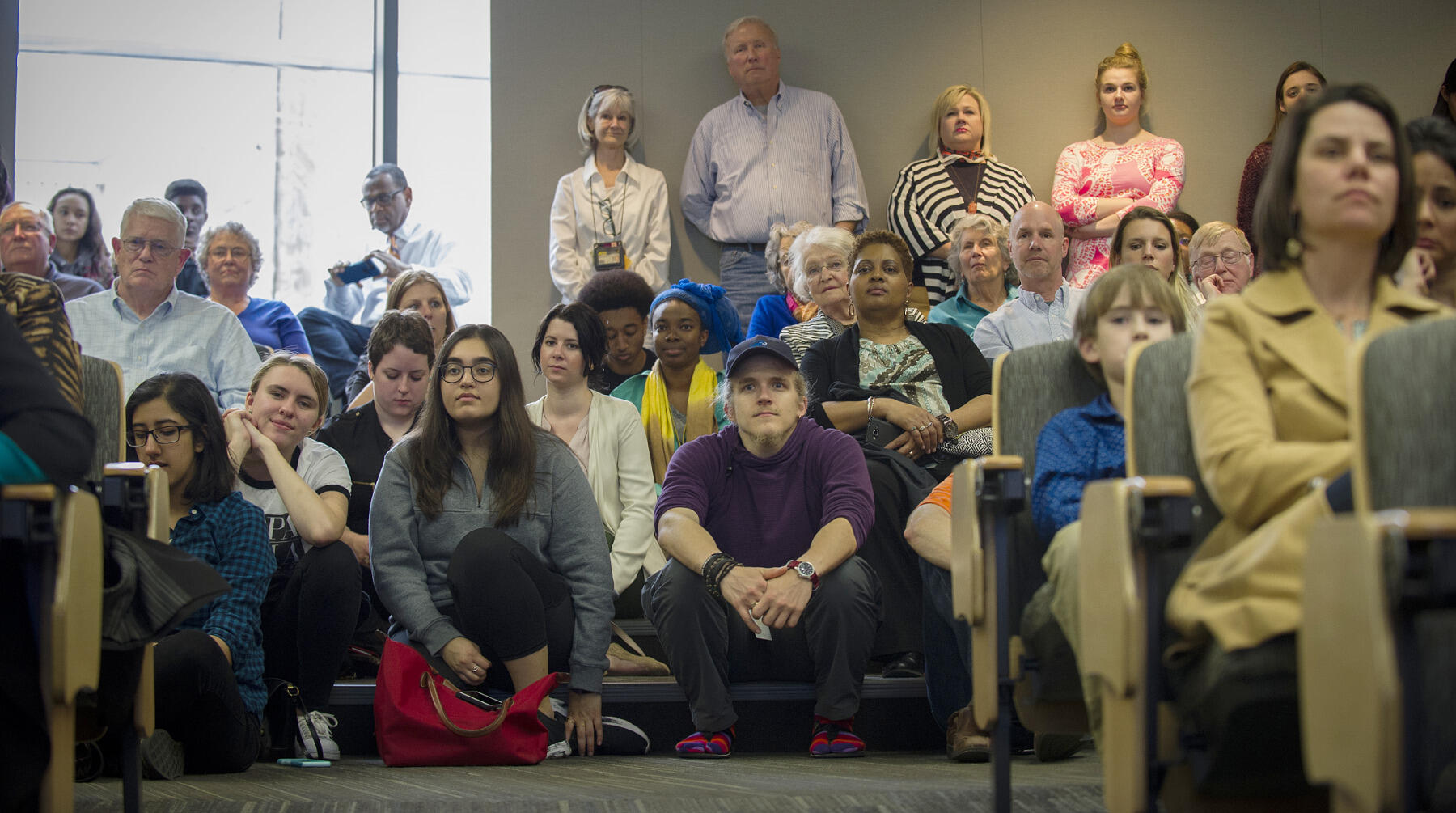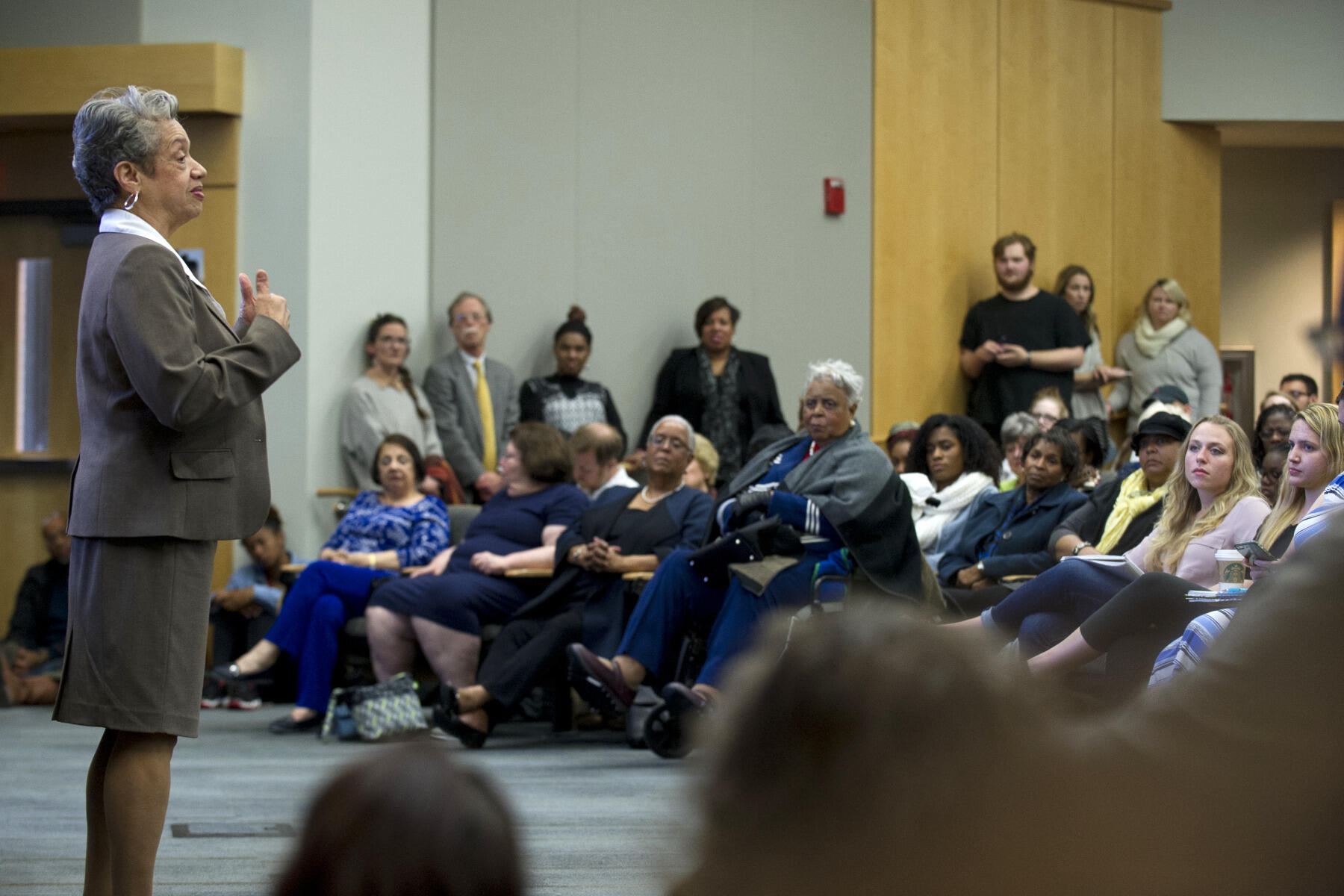
<br>Photos by Julia Rendleman.
April 8, 2017
Christine Darden, featured in ‘Hidden Figures,’ talks sonic booms and her career at NASA
Share this story
When Christine Darden, Ph.D., was hired by NASA as a data analyst at Langley Research Center in Virginia in 1967, she felt immeasurable pride. She had been swept up by the excitement over the space race ever since she was a high school senior when the Russians launched Sputnik and later when John Glenn passed Hampton University – where she was studying math – in a parade after successfully orbiting Earth.
So you know I had to be proud to walk into NASA.
“The whole country was kind of excited about the space program. [The feeling was] we’re going to get to the moon. We’re going to beat the Russians. And all the schools and everybody was behind it. So you know I had to be proud to walk into NASA. And I am no less proud today because I think they do great work,” she said. “I just think they put me in the wrong place.”
Darden is a retired NASA mathematician, data analyst and aeronautical engineer who was featured in “Hidden Figures: The Story of the African-American Women Who Helped Win the Space Race,” a 2016 book by Margot Lee Shetterly, which was adapted into the critically acclaimed film “Hidden Figures.” She spoke Friday at Virginia Commonwealth University before a standing room-only crowd of hundreds.
Her talk was sponsored by VCU’s Departments of Mathematics and Applied Mathematics; African-American Studies; and Gender, Sexuality and Women's Studies in the College of Humanities and Sciences.
At NASA, Darden was assigned to work as part of a pool of “human computers” – women who wrote complex programs and crunched numbers for engineers. She was placed into this role even though she had attained the same level of education – a master’s degree in applied mathematics – as the male engineers.
“As I was working there, I realized that the engineers on the hall were theoretical engineers. They were really using math. They were doing the same kind of work that I had done working on my master’s degree at Virginia State. And I said, ‘Well, you know, this is really what I would like to be doing,’” she said. “I started asking my supervisors, ‘Can I transfer to an engineering area?’ And they said, ‘No, that’s impossible.’ ‘Can I go to graduate school?’ ‘No, we don’t think you can do that.’”

After a couple of years of getting her ambitions shot down by her supervisors, she decided to go above their heads and ask a NASA director.
“I went to a director who was several levels higher and said, ‘I’d like to know why a female coming here, with the same background as many of the engineers – the same mathematics or applied mathematics degree – why the men are assigned to an engineering job, where they work on their own projects, they write their own papers, they go give talks and they get promoted, and the women are put in computer sections where they solve equations for the engineers and give them the answers, and they go off and publish the paper and may or may not have even put the [woman’s] name on the paper?’”
Nobody, the director told her, had ever asked that question before.
“I said, ‘Well, I’m asking that question now,’” she said. “Well, he, I think, was in a good mood that day or something. He transferred me to an engineering section, and he promoted me – I had not had a promotion since I’d been there.”
Darden was assigned to NASA’s sonic boom minimization group. Over the next 25 years, she and her colleagues dedicated themselves to reducing the sonic boom effect to one day clear the way for supersonic commercial air travel.
“Those of you in this room would still like to be able to get to Los Angeles in an hour. You’d like to be able to get from Los Angeles to Australia in six to eight hours, rather than 14 hours. And so people want to go fast,” she said. “NASA says, ‘Is there any way that we can reduce that sonic boom?’”
In the 1960s, the United States, the Soviet Union, France and England all launched projects to build supersonic commercial airplanes. The French and English rolled out the Concorde, the Russians’ TU-144 never succeeded in making commercial flights, and the United States’ effort proved hamstrung by the sonic boom created by breaking the sound barrier.
“The United States did some flight tests over Oklahoma City and Chicago,” Darden said. “They got military airplanes that flew supersonically. They flew over those cities and they had phone banks set up so that people could call in with their reactions to these sonic booms. And they got criticism like, ‘Oh, you cracked the sheetrock in my house. You broke my China. You broke my windowpanes.’”
As a result of those test flights, the U.S. canceled its supersonic transport program and enacted laws banning supersonic commercial flights over land.
However, the promise of of supersonic commercial air travel led NASA to pursue research into minimizing the sonic boom effect, and Darden was at the center of those efforts.
“[After joining the team,] I was given a technical paper that had a set of equations in it,” she recalled. “My boss said, ‘I want you to write a program that solves these equations. This will give us the equivalent area distribution of an airplane that minimizes its sonic boom, if you knew the Mach number, the altitude, the weight and the length of that airplane.’ So I wrote that program over the course of the next several months. And then, once we started using that program, I and a couple other guys working with me started designing airplanes.”
Darden and her colleagues succeeded in designing a model that minimized sonic booms. And they eventually partnered with the Defense Advanced Research Projects Agency to modify an F-5 jet to incorporate their sonic boom minimization technology. In 2002, a test flight indicated that their efforts were working.
“When we measured the signature off the [modified] airplane, we saw the shape that we wanted, the shape that we had been going for, that actually cut off the top of the N-wave,” she said. “We were saying, well it’s working. The theory is working. What we’d been doing to reduce the sonic boom works.”
The next step, she said, would be to integrate the sonic boom shaping technology with supersonic airplane technology into one airplane. NASA, she said, has been awaiting funding to get the project underway.
“Since 2002, NASA has been waiting for money to build a full-scale airplane that would have this sonic boom technology in it. I understand that the money is supposed to be in the 2017 budget, which has still has not been voted [on]. And then we don’t know what’s going to happen with the 2018 budget yet,” she said. “But it has been on the news that NASA is supposed to build two X-planes this year – one a subsonic airplane, one a supersonic airplane. The supersonic airplane would be the one that would demonstrate this technology.”
If the funding comes through and the technology works in curbing sonic booms, she said, it could lead the FAA to remove the bans on supersonic commercial flights and would spark a revolution in the air travel industry.
“If Boeing would spend $1 billion to develop this airplane, they could sell thousands and thousands of these airplanes to recoup their money,” she said. “And you could get to California in an hour.”
In a question-and-answer session after her talk, Darden was asked why her contributions to aeronautical engineering at NASA and to the field of sonic boom science is only now being recognized, having been featured in the “Hidden Figures” book.
She responded that she had long been recognized within her field, but is proud that the public recognition she and the others in “Hidden Figures” are now enjoying might be inspiring people to pursue careers in science, technology, engineering and math.
“All of a sudden, the whole world knows what some of the people did at NASA. And I think that’s good,” she said. “And I think if it is inspiring our young people to take algebra 1, to take geometry, then that’s wonderful.”
She added that at her retirement party from NASA, one young woman talked about how she studied engineering after reading about Darden in an Ebony magazine article. Another talked about how she went into engineering after hearing Darden talk at her high school.
“They actually said that, ‘If you can do that, then I can do that too,’” she said. “And they both became engineers at NASA Langley.”

Subscribe for free to the VCU News email newsletter at http://newsletter.news.vcu.edu/ and receive a selection of stories, videos, photos, news clips and event listings in your inbox every Monday and Thursday.
Subscribe to VCU News
Subscribe to VCU News at newsletter.vcu.edu and receive a selection of stories, videos, photos, news clips and event listings in your inbox.












